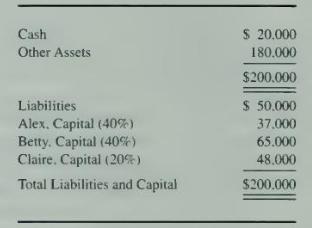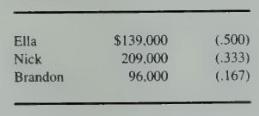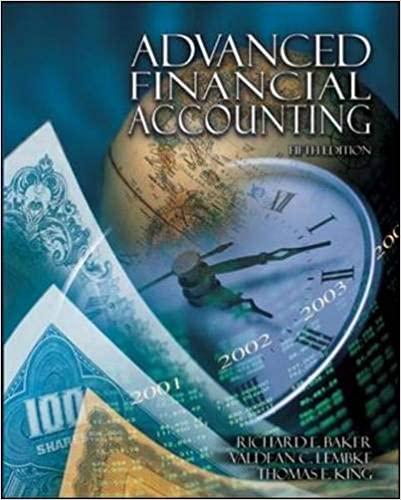Select the correct answer for each of the following questions. The following balance sheet is for the
Question:
Select the correct answer for each of the following questions.
The following balance sheet is for the partnership of Alex, Betty, and Claire, and relates to questions 1 and 2 :

1. If the assets are fairly valued on the above balance sheet and the partnership wishes to admit Denise as a new one-sixth-interest partner without recording goodwill or bonus, Denise should contribute cash or other assets of:
a. \(\$ 40.000\)
b. \(\$ 36.000\)
c. \(\$ 33,333\)
d. \(\$ 30,000\)
2. If assets on the initial balance sheet are fairly valued. Alex and Betty consent and Denise pays Claire \(\$ 51.000\) for her interest; the revised capital balances of the partners would be:
a. Alex, \(\$ 38.000\) : Betty, \(\$ 66,500\); Denise, \(\$ 51,000\).
b. Alex, \(\$ 38,500\) : Betty, \(\$ 66,500\) : Denise, \(\$ 48.000\).
c. Alex, \(\$ 37,000\) : Betty, \(\$ 65,000\) : Denise, \(\$ 51,000\).
d. Alex, \(\$ 37,000\) : Betty, \(\$ 65,000\); Denise, \(\$ 48,000\).
3. On December 31, 20X4, Alan and Dave are partners with capital balances of \(\$ 80,000\) and \(\$ 40,000\), and they share profit and losses in the ratio of \(2: 1\), respectively. On this date Scott invests \(\$ 36,000\) cash for a one-fifth interest in the capital and profit of the new partnership. The partners agree that the implied partnership goodwill is to be recorded simultaneously with the admission of Scott. The total implied goodwill of the firm is:
a. \(\$ 4,800\).
b. \(\$ 6,000\).
c. \(\$ 24,000\).
d. \(\$ 30,000\).
4. Boris and Richard are partners who share profits and losses in the ratio of 6:4, respectively. On May 1, 20X9, their respective capital accounts were as follows:

On that date, Lisa was admitted as a partner with a one-third interest in capital and profits for an investment of \(\$ 40,000\). The new partnership began with a total capital of \(\$ 150,000\). Immediately after Lisa's admission, Boris's capital should be:
a. \(\$ 50,000\).
b. \(\$ 54,000\).
c. \(\$ 56,667\).
d. \(\$ 60,000\).
5. At December 31, Rod and Sheri are partners with capital balances of \(\$ 40,000\) and \(\$ 20,000\), and they share profits and losses in the ratio of \(2: 1\), respectively. On this date Pete invests \(\$ 17,000\) in cash for a one-fifth interest in the capital and profit of the new partnership. Assuming that the bonus method is used, how much should be credited to Pete's capital account on December 31?
a. \(\$ 12,000\).
b. \(\$ 15,000\).
c. \(\$ 15,400\).
d. \(\$ 17,000\).
6. The capital accounts of the partnership of Ella, Nick, and Brandon are presented below with their respective profit and loss ratios:

Tony was admitted to the partnership when he purchased directly, for \(\$ 132,000\), a proportionate interest from Ella and Nick in the net assets and profits of the partnership. As a result, Tony acquired a one-fifth interest in the net assets and profits of the firm. Assuming implied goodwill is not to be recorded, what is the combined gain realized by Ella and Nick upon the sale of a portion of their interests in the partnership to Tony?
a. \(\$ 0\).
b. \(\$ 43,200\).
c. \(\$ 62,400\).
d. \(\$ 82,000\).
7. Fred and Ralph are partners who share profits and losses in the ratio of \(7: 3\), respectively. Their respective capital accounts are as follows:

They agreed to admit Lute as a partner with a one-third interest in the capital and profits and losses, upon an investment of \(\$ 25,000\). The new partnership will begin with a total capital of \(\$ 90,000\). Immediately after Lute's admission, what are the capital balances of Fred, Ralph, and Lute, respectively?
a. \(\$ 30,000, \$ 30,000, \$ 30,000\).
b. \(\$ 31,500, \$ 28,500, \$ 30,000\).
c. \(\$ 31,667, \$ 28,333, \$ 30,000\).
d. \(\$ 35,000, \$ 30,000, \$ 25,000\).
8. If \(A\) is the total capital of a partnership before the admission of a new partner, \(B\) is the total capital of the partnership after the investment of a new partner, \(C\) is the amount of the new partner's investment, and \(D\) is the amount of capital credit to the new partner, then there is:
a. A bonus to the new partner if \(B=A+C\) and \(D
b. Goodwill to the old partners if \(B>(A+C)\) and \(D=C\).
c. Neither bonus nor goodwill if \(B=A-C\) and \(D>C\).
d. Goodwill to the new partner if \(B>(A+C)\) and \(D
Step by Step Answer:

Advanced Financial Accounting
ISBN: 9780072444124
5th Edition
Authors: Richard E. Baker, Valdean C. Lembke, Thomas E. King





